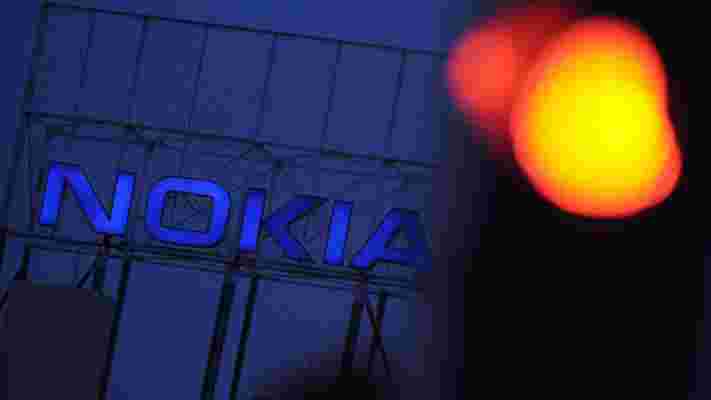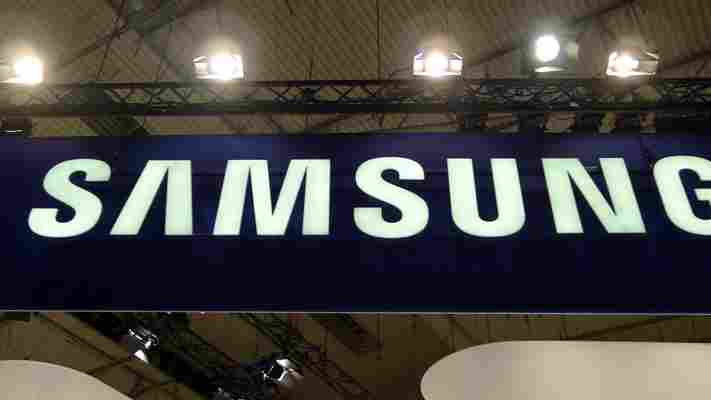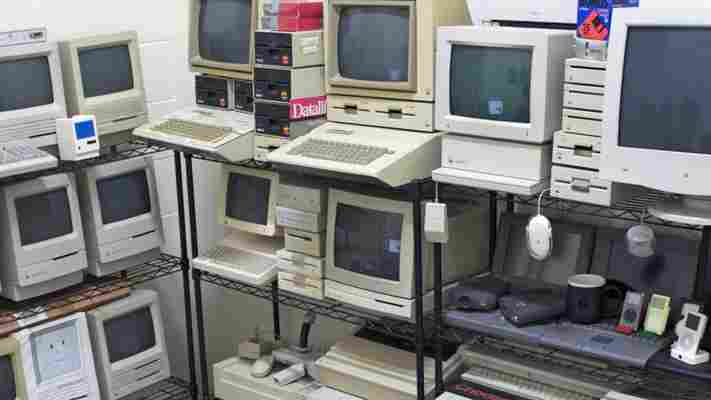At Nokia World in Abu Dhabi today, Nokia introduced a portable wireless charging plate called the Nokia DC-50. The device retail for $99 when it arrives “globally” in the final quarter of this year.

The Nokia DC-50 is supposed to make charging both easier and faster by letting people wirelessly charge their smartphone anytime and anywhere. Supporting the Qi wireless standard, it is compatible with Nokia Lumia devices supporting wireless charging, including the Lumia 1520, Lumia 1020, Lumia 925, and Lumia 920.
Images via Nokia
Samsung unveils the NX2000, a 20.3MP compact system camera that connects with Android and iOS devices
Samsung has added the NX2000 to its range of compact interchangeable lens cameras today, boasting an impressive 20.3 megapixel sensor and Wi-Fi connectivity using the company’s SMART CAMERA app.

The NX2000 continues Samsung’s trend of offering modern, bold designs in a small camera body. It’s miles away from what Olympus is doing with the PEN series and Fujifilm with the X100 and X10 , but it’s carved out a significant following all the same.
Professional photographers and hobbyists alike will be pleased to know that the NX2000 can be pushed to a staggering 1/4000 shutter speed for capturing sports and action shots, as well as up to 8 frames per second for continuous burst mode shooting.
Coupled with a wide ISO range – 100 to 25600 – and the aforementioned 20.3 megapixel ASP-C CMOS sensor, it’s fair to say that the NX2000 can capture some seriously sharp and detailed images.
The latest addition to the NX family is aimed at entry-level or mid-level photographers who prefer to keep the camera locked on auto, however. There’s a mode dial on top, but the back of the device has just three buttons for recording video, reviewing shots and going back to the home screen. DSLR-enthusiasts will be left disappointed.
Instead, most of the body is taken up by a large 3.7-inch WVGA touch screen. It’s bright and easy to use, with a SMART mode that offers various aids and scene modes for “taking the perfect shot”.
There’s a whole load of other PR-branded features and gimmicks here too, such as ‘Best Face’, which takes five consecutive photos and lets the user choose the best facial expression and ‘Action Freeze’ for fast-moving subjects.
The NX2000 also offers Wi-Fi connectivity, which is a huge advantage over other compact and micro four thirds cameras currently on the market. The body houses Samsung’s SMART CAMERA 2.0 software, which enables a whole host of options for sharing and storing images directly rom the camera.
It also links up with the Samsung SMART CAMERA app on iOS and Android, which lets photographers instantly access and upload their images using a smartphone. The NX2000 also comes with Near Field Communicaiton (NFC) for pairing the device with other compatible hardware over Wi-Fi.
It’s a clever idea and combats the need from consumers to be constantly uploading photos to services such as Instagram, Flickr or Twitter. Users can also sync their favorite services to a ‘Direct Link’ hot key for one-touch sharing.
Available for $649.99 in white, black and pink, the NX2000 will support 12 interchangeable lenses including Samsung’s 45mm 3D lens, for viewing on compatible 3D TVs.
30 years in 33 photos: A visual history of the Apple Mac
The Macintosh is 30 years old today. Over the next few days, we’ll be taking a look at the past and future of the Mac platform, starting off with a visual history of how the computer has evolved over the past few decades.

For an in-depth look at how the first Macintosh came to be, you can also check out original team member Andy Hertzfeld’s invaluable Folklorerg site.
The first Mac cost $2,495, or $5,594 when adjusted for inflation . It made use of Motorola’s 68000 processor with 128KB of RAM. The included 9-inch display had a resolution of 512×342 pixels. The computer was noteworthy for its first commercial application of a graphical user interface, mouse input, and the inclusion of a 3.5-inch floppy drive.
Prior to the unveiling of the Macintosh project at Apple’s annual shareholder meeting on January 24, the company teased the device in a now-iconic Super Bowl ad riffing on George Orwell’s “1984.” While the spot has been hailed as one of the greatest pieces of advertising, a second ad, “ Lemmings ,” was reviled the following year.
http://www.youtubeom/watch?v=g_d5R6Il0II
The shareholders meeting literally set the stage for Steve Jobs to show off his signature flair for drama. While later unveilings, like the first iMac, iPod, iPhone and iPad, would also capture the world’s attention, it was the Mac that started it all.
Credits: Ken Fager / Flickr , Folklorerg , All About Apple / Wikimedia , EveryAppleAd, Scott Knaster
Next: Macintosh Plus | Read on one page
Following a minor update to the original Macintosh, Apple released the Macintosh Plus, which added a SCSI port and more memory. The computer earned the distinction of becoming the longest-produced Mac for Apple by filling the low-end spot in the product lineup after the Macintosh SE and II arrived.
Credit: br1dotcom / Flickr
Next: Macintosh SE | Read on one page
The $3,700 Macintosh SE added hard drive and expansion slots and changed to a new connector for the mouse and the keyboard. It was also the first Mac to include a cooling fan.
Credit: shaniber / Flickr
Next: Macintosh II | Read on one page
The Macintosh II cost a hefty $6,500, representing a move away from individual consumers and more toward businesses. The machine had a modular case and strong expandability, and unlike the original Mac models, it split the case and monitor into separate pieces.
Credit: Wikimedia
Next: Mac Portable | Read on one page
Apple didn’t get its first portable right, but the company was correct in predicting that many consumers would eventually shift to laptops as their main computers. The Mac Portable cost a steep $6,500, and included a 16MHz processor and a sealed lead acid battery with a long charge.
Macintosh team veteran Andy Hertzfeld described the Mac Portable as his least favorite Mac because it was “incredibly expensive and incredibly heavy.”
Credit: alvy / Flickr
Next: Mac Classic | Read on one page
Apple went back to its roots in 1990 with the Mac Classic. The model finally hit the sub-$1,000 price point that the original Macintosh team had been aiming for. Of course, the low price came at a trade-off, leaving the Mac Classic under-powered for its time.
Credit: abeckstrom / Flickr
Next: Quadra 700 | Read on one page
The 1990s were a dark time for Apple, as the company struggled with poor management and fierce competition. The Quadra represents just one of many Mac desktop lines that the company tried to throw against the wall. This particular model had the dubious distinction of being able to switch between vertical tower and landscape desktop modes.
Credit: All About Apple
Next: Powerbook 100
Learning from its failure with the Mac Portable, Apple created the PowerBook 100. You’ll recognize it as a proto version of the Mac laptops that have become nearly ubiquitous today. The PowerBook line was a bright spot for the company, bringing in more than $1 billion in revenue in its first year and eventually winning recognition as one of the greatest computers of its era.
Credit: microraptor / Flickr
Next: Macintosh TV | Read on one page
At this point in Apple’s history, Mac models start to become a blur, but the Macintosh TV definitely stands out. Sadly, it wasn’t very good. In retrospect, it does feel quite ahead of its time, though. Some of we current Mac users have taken to using our computers as our main device for watching content, with some even going so far as to cancel their cable subscriptions and switch to all digital.
Credit: mjtsai / Flickr
Next: Power Macintosh | Read on one page
There’s not much noteworthy about the first Power Macintosh, but the device family would live on for over a decade. Bland desktops like this one represent the struggling state Apple was in as it tried to rediscover its roots.
Credit: All About Apple
Next: 20th Anniversary Macintosh | Read on one page
The $7,499 limited-edition 20th Anniversary Mac pretty much represents Apple hitting rock bottom before Jobs’s return. Oddly enough, it was designed by Jony Ive, the Apple designer that would go on to achieve rock star-level recognition under Jobs.
“The 20th Anniversary Macintosh, I think really describes a whole new product type,” Ive said at the time.
It certainly was a new product type, just not a good one. Andy Hertzfeld told us that he hated the computer when it came out.
“It didn’t have a philosophy that was utilitarian, it was phony futuristic … It cared about looking futuristic and different more than being functional.”
Credit: Robin Kearney / Flickr
Next: iMac
The original iMac is the second-most important Macintosh that Apple released. Jobs needed a hit to prove that Apple was still in the game, and this was it.
Apple used the iMac to launch the company fully into the Internet age and established the “i” branding that would carry through to its iPod, iPhone and iPad lines.
Apple’s decision to adopt the USB standard was highly criticized at the time, but it turned out to have an enormous impact on the industry. The bright “Bondi Blue” color signaled Apple’s return to playfulness and different design, setting it apart from the nearly indistinguishable commodity beige boxes that had flooded the market.
Credits: John G. Mabanglo / AFP / Getty Images, Masashige MOTOE / Flickr
Next: Power Macintosh G3
Jobs took the visual style of the first iMac and spread it throughout Apple’s product lineup. The Power Macintosh G3 also introduced an interesting swinging door design that provided easy access to the logic board.
Credit: Mac Users Guide
Next: iBook
The clamshell iBook felt like Apple’s first modern laptop. It marked the Mac’s transition to the world of wireless networking and, thus, true portability.
Credit: Mac Users Guide
Next: PowerMac G4 (Graphite)
After making a splash with the bright colors of the iMac, Apple dialed back its design language with machines like the graphite PowerMac G4. Even 14+ years later, the G4’s style, lines and colors are close to fitting in with today’s Macs.
Credit: Wikimedia
Next: PowerMac Cube
While the PowerMac Cube is one of Jobs’s most recognizable product failures, many still look back fondly on the Cube as a work of art. The machine was over-priced, suffered from production flaws, and was prone to overheating.
Credit: John G. Mabanglo / AFP / Getty Images
Next: PowerBook Titanium
A number of Mac owners I’ve spoken with have put forth the Titanium PowerBook as their favorite ever. While Apple has achieved a more consistent look with its aluminum MacBook Pro and Air lines, the “TiBook,” as it was affectionately referred to, was a workhorse. This was the pinnacle of the pre-Intel era.
Credit: John G. Mabanglo / AFP / Getty Images
Next: iMac G4
Perhaps it’s because the iMac G4 reminds me of Luxo Jr. , Pixar’s first short film, but this is another one of my favorite Macs. The design was short-lived, but it had surprisingly strong adoption among small businesses.
Credit: John G. Mabanglo / AFP / Getty Images
Next: PowerBook (Aluminum)
Apple first switched to aluminum with the release of its 12-inch and 17-inch PowerBooks in 2003. The 12-inch version managed to feel both compact and powerful, while the 17-inch was enormous nearly to the point of ridicule. Still, you instantly felt more productive and creative whenever you pulled the 17-inch PowerBook out of its custom-made bag and awkwardly perched it on your under-sized coffee shop table. At least, that’s how we remember it.
Credit: Justin Sullivan / Getty Images
Next: PowerMac G5
The PowerMac G5 was hot. Literally. While it was hailed as one of the fastest computers on the market when it arrived, all that performance required loads of cooling. We didn’t know it at the time, but this was the pinnacle of the PowerPC platform.
Credit: Wikimedia
Next: iMac G5
The overall form of the iMac G5 has lasted for nearly a decade. With its tiny footprint, it looked more like a display than a computer. This was the fulfillment of Apple’s vision for an all-in-one computer.
Credit: Stephane de Sakutin / AFP / Getty Images
Next: Mac mini
Apple made up for its failure with the Cube by producing the Mac mini. Its price was newsworthy on its own, as it represented the first time that the Mac had reached truly affordable levels. The device came with quite a few compromises, but it was a great entry point for switchers who already had the required accessories and had held off on trying out Macs because of the premium pricing.
Credit: Justin Sullivan / Getty Images
Next: iMac Core Duo (Intel)
For Apple fans, the transition to Intel felt a bit like making a deal with the devil, but the shift turned out to be remarkably smooth. Apple had been running OS X on Intel on the side for years, even as it built up frustration with the issues the PowerPC architecture was having.
This iMac Core Duo came at a crucial moment for the long-term survival of the Mac and it managed to pass the test.
Credit: Justin Sullivan / Getty Images
Next: MacBook Pro
Apple followed its success with the iMac by switching its MacBook Pro to Intel. With the exception of a few modifications, the company has stuck with this design for its pro-line of laptops.
Credit: Justin Sullivan / Getty Images
Next: MacBook
Black Macs were back in style with the arrival of the MacBook. Sure, you’d have to pay a couple hundred extra dollars for the privilege, but that didn’t stop many of you from falling for that beautiful matte finish. As for the white MacBook model, countless term papers have been written on those machines, thanks in part to Apple’s free iPod back-to-school deals.
Credit: sparktography / Flickr
Next: Mac Pro
Power users had the most to lose in the transition to Intel, and Apple took its time building the Intel-equipped Mac Pro. The machine kept the aggressive look of the PowerMac G5 and included much of its expandability.
Credit: Justin Sullivan / Getty Images
Next: MacBook Air
The first MacBook Air was overpriced for what it offered, but future improvements and cost cuts have made it a success. In fact, features that started out on the Air have since made their way back to the MacBook Pro. The wedge-shaped laptop may have had a small start, but it has grown to become many users’ favorite Mac. Now it even has an iPad named after it.
Credit: Tony Avelar / AFP / Getty Images
Next: MacBook Pro (Unibody)
Apple’s new unibody chassis managed to make milling sexy for a time. Using a single block of aluminum made MacBooks both thinner, stronger and lighter, while giving Jony Ive a world of opportunities to say the word “aluminium.”
Credit: Justin Sullivan / Getty Images
Next: MacBook Pro Retina
With the new MacBook with Retina Display , Apple turned its attention to improving the screen. Adding all those pixels turned out to be a costly affair, but the price has since come down. The current crop of Retina MacBook Pros offer the performance of a professional-grade notebook while including some of the best elements of the MacBook Air.
Credit: Kimihiro Hoshino / AFP / Getty Images
Next: iMac
After years of the same iMac design, Apple changed things up with a new tapered look and a hybrid Fusion drive that combines SSD with a traditional hard drive. When compared against the original Macintosh, it’s amazing to see how much Apple has managed to shrink down the computer, improving performance and drive down prices over the years.
Credit: Kvork Djansezian / Getty Images
Next: Mac Pro
The new Mac Pro represents one of the most significant evolutions to a Mac product in recent years. Apple ditched the grating and aluminum look that it had kept for a decade and shrunk the computer into a compact cylinder. The company has also come full circle by once again assembling Macs in the US.
Apple barely managed to make its deadline of the end of 2013, and orders are backed up until March, but the Mac Pro offers an early look at what Apple has planned for the next decade of Macs. Who knows, maybe we’ll see a return of the black MacBook?
Keep an eye on our
Related: What to expect from Apple in 2014: A new product category and the beginnings of convergence
Credits: Apple, Josh Edelson / AFP / Getty Images, MATEUS_27:24&25 / Flickr
